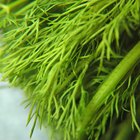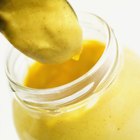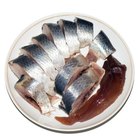
EllenMol1814/iStock/Getty Images
A condiment is a substance used to add flavor to a finished dish at the table. Condiments are often a prepared sauce or liquid that eliminates salt, pepper and herbal sprinkles. The top-selling condiments in the United States run the gamut from those with an Asian influence to condiments with notes of French sophistication or even down-home American ingenuity.
Ketchup
Ketchup may not be the best-selling condiment in the U.S., but it's certainly the most iconic. However, ketchup originated in Asia -- as a tomato-free fermented fish sauce. The Dutch brought it to Europe; the British brought it to the Colonies; and, in the 1800s, the horticulturalist James Mease had the bright idea to add tomatoes to the recipe. A star was born, and today, 97 percent of U.S. households boast a bottle in the fridge somewhere.
Mustard
As a condiment, mustard has an ancient lineage. Mustard seed is one of the few spices native to Europe -- as well as Asia -- and the Romans may have been the first to concoct a pungent paste from mustard seeds and wine. They passed their recipes on to the medieval Gauls in what is present-day France, which is one reason why French mustard in particular has such a well-regarded reputation. Mustard can be made from simple water plus ground mustard seeds; you can also use vinegar, wine, verjus or even beer to replace the water. Mustard wins a top spot among U.S. condiments thanks to its status as the preferred topping for the all-American hot dog, popularized at the 1893 Columbian Exposition.
Mayonnaise
According to research published at Quartz.com, in 2013 mayonnaise outsold any other condiment dollar-for-dollar in the U.S. Mayonnaise is an emulsion of oil and egg, often seasoned with lemon juice or vinegar for a tart taste. It originated in either France or Spain, depending on whom you ask, in the 18th century. As a condiment, it's best-known as a sandwich spread, but in some areas it's also used as a dip for French fries. Mayonnaise also welcomes additions such as pesto, garlic, fresh herbs or ground chili pepper.
Soy Sauce
Soy sauce may just be the world's oldest condiment, but, although it arrived in the Americas in the 17th century via Dutch traders, it took its own sweet time becoming an established pantry staple in the U.S. Interestingly, the early history of soy sauce and ketchup in Western cuisines are closely intertwined, with the term "soy" and variations such as "shoyu" or "soja" and the terms "ketchup" or "catsup" nearly interchangeable. The condiment as we know it today caught on in postwar America thanks in part to heavy marketing by the Japanese company Kikkoman. Consisting primarily of fermented soybeans and salt, soy sauce enhances the flavor of a variety of foods, from stir-fries to steaks.
Hot Sauce
The term "hot sauce" can refer to any sauce that features chili peppers as the main ingredient, but the quintessential American version of this condiment consists simply of hot peppers, vinegar and salt; sometimes, this mix is then aged in wooden barrels for extra flavor. This style of hot sauce is often referred to as "Louisiana-style" hot sauce, an indication of its all-American origins. The first such sauce to be marketed commercially made its debut under the Tabasco brand name in the mid-19th century, although it's only since 2000 that it's reached the pinnacle of its popularity, earning it a spot in the top five condiment list.
Related Articles
The History of Teriyaki Sauce

Classic Russian Spices

What Can I Serve With Sweet Chili Sauce?

What Is Chipotle Seasoning?

Can You Refreeze Cooked Spaghetti Sauce ...

Can I Substitute Mustard for Moutarde ...

Peruvian Cooking Spices

Tanqueray Gin Ingredients

What Is Mustard Flour?

The History of Bearnaise Sauce

Herring in Wine Sauce

Bohemian Cooking

What Sauce to Serve With Deep-Fried ...

How to Make Eggs Benedict With ...

Catholic/Irish Surnames

Types of Pasta Sauces With Tortellini

How to Make Fish Taco Sauce

The Ingredients in Chipotle Sauce

What Is Lime Cordial?

How to Make a Real, Authentic Ponzu ...
References
- Quartz: Ketchup Isn't the King of American Condiments. Mayonnaise Is.
- NPR: Ketchup -- The All-American Condiment That Comes From Asia
- The Atlantic: Making Homemade Mustard -- Easier Than You Think
- National Hot Dog and Sausage Council: Hot Dog History
- Slate: A Brief History of Mayonnaise
- Soy Info Center: History of Soy Sauce
- The Economist: Sauce of Success
- New York Times: Who Made That Tabasco Sauce?
- Quartz: The American Hot Sauce Craze in One Mouth-Watering Chart
Writer Bio
Lori A. Selke has been a professional writer and editor for more than 15 years, touching on topics ranging from LGBT issues to sexuality and sexual health, parenting, alternative health, travel, and food and cooking. Her work has appeared in Curve Magazine, Girlfriends, Libido, The Children's Advocate, Decider.com, The SF Weekly, EthicalFoods.com and GoMag.com.
Photo Credits
EllenMol1814/iStock/Getty Images